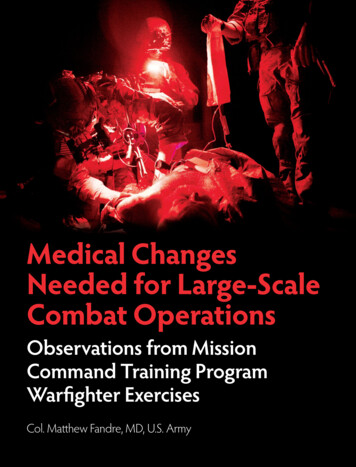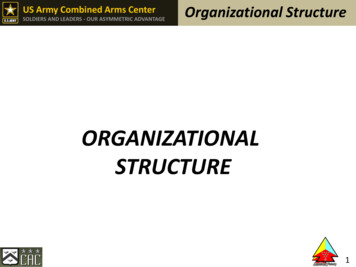
Transcription
MISSION COMMAND TRAINING PROGRAMFORT LEAVENWORTH, KANSASMCTP Trends in a Decisive ActionWarfighter ExerciseCOL Edward T. BohnemannCommander, MCTP
MCTP FY14 Trends in a Decisive Action WFXTable of ContentsIntroduction . 51. WFX Execution . 71.1. Trends by Warfighting Function . 71.1.1. Mission Command: . 71.1.1.1. Inconsistent Use of Operational Frameworks . 71.1.1.2. Linking Commander’s Critical Information Requirement (CCIR) to Decisions . 81.1.1.3. Battle Rhythm Management . 91.1.1.4. Knowledge Management Framework . 101.1.1.5. Special Operation Forces (SOF)/Conventional Force (CF) Interdependence . 111.1.1.6. Shaping Operations in the Deep, Close, and Security Fight at the Division Level . 111.1.1.7. Planning Horizons and Plans Management . 121.1.1.8. Rehearsals . 151.1.1.9. Command Posts (CPs) . 151.1.1.10. Military Decision Making Process (MDMP) Synchronization . 161.1.2. Movement and Maneuver . 161.1.2.1. Common Operational Picture (COP) . 161.1.2.2. Current Operations Integration Cell (COIC) Functionality . 171.1.2.3. Responsibilities for Support Area Management and Movement Control Planning . 171.1.2.4. Wet Gap Crossing . 181.1.2.5. Understanding Combat Aviation Brigade (CAB) Capabilities . 191.1.3. Intelligence . 211.1.3.1. Product Support to Intelligence Preparation of the Battlefield (IPB) . 211.1.3.2. IPB and Running Estimates that Assess the Hybrid Threat . 221.1.3.3. Predictive Analysis . 221.1.3.4. Intel Inputs to Targeting Working Groups (TWG) . 231.1.3.5. Information Collection Asset Prioritization and Synchronization. 231.1.3.6. Unmanned Aerial System (UAS) Integration . 241.1.4. Fires . 251.1.4.1. Division vs. Brigade Fight (Deep Attack) . 251.1.4.2. Linking Targeting to Shaping Operations . 261.1.4.3. Airspace Control and Fires De-confliction . 271.1.4.4. Combat Assessments in the Planning Process . 271.1.4.5. Integration of Information Operations into the Targeting Cycle . 281.1.4.6. Graphic Control Measures . 29
MCTP FY14 Trends in a Decisive Action WFX1.1.4.7. Fires Planning . 291.1.5. Sustainment . 301.1.5.1. Distribution Management . 301.1.5.2. Organizing Sustainment Staffs by Warfighting Functions . 311.1.5.3. Operational Area Security . 321.1.5.4. Sustainment Running Estimates . 331.1.5.5. Conducting Parallel Planning . 331.1.5.6. Sustainment Reporting . 341.1.6. Protection . 351.1.6.1. Oversimplification of Protection Efforts . 351.1.6.1. Critical Asset List/Defended Asset List – Usage, Revision, and Linkage . 351.1.6.3. Protection Working Groups . 361.1.6.4. Development of the Critical Asset List/Defended Asset List . 371.2. Missions Aligned to Organic Capabilities . 371.3. Integration of Functional and Multifunctional Brigades . 381.4. Special Staff . 391.4.1. Operational Law (OPLAW) . 391.4.1.1. OPLAW Integration with Staff. 391.4.1.2. Staff Judge Advocate’s (SJA) Role in the MDMP . 391.4.1.3. Workstation Locations in the Command Post . 401.4.2. Religious Support . 401.4.2.1. Religious Support Common Operational Picture . 401.4.2.2. Religious Support Integration in the MDMP . 411.4.2.3. Religious Support to Mass Casualties (MASCAL) . 411.4.2.4. Religious Battle Tracking . 411.4.3. Public Affairs . 421.4.3.1. Integration of Public Affairs in Staff . 421.4.3.2. Public Affairs Annex and Guidance . 421.5. Cyber Electromagnetic Activities (CEMA) . 431.5.1. Trained Personnel to Plan, Coordinate, and Integrate Cyberspace Operations . 431.5.2. Integration of Electronic Warfare . 431.5.3. Organic CEMA equipment . 44
MCTP FY14 Trends in a Decisive Action WFX2. Warfighter Exercise Design . 452.1. Exercise Planning (Exercise Lifecycle Events) . 452.1.1. Establish Effective Training Objectives for a Warfighter Exercise . 452.1.2. Preparation. 452.1.3. Mission Command Training . 462.2. HICOM Manning . 462.3. Participants in a Warfighter . 462.3.1. Task Organization (Annex A) . 462.3.2. Training Level (Perishable/Non-Resident) . 472.4. Orders Production Timeline . 472.5. Joint Force Component Integration . 483. Warfighter Technical Design . 493.1. Mission Command Information Systems (MCIS) . 493.1.1. Equipment Availability . 493.1.2. Version Control . 503.1.3. Home Station Training . 503.1.4. Field Service Representative Support . 513.2. Pre-Start Exercise (STARTEX) – Communication Exercise (COMMEX) . 513.3. Network Management/Architecture . 523.4. DoD Information Assurance Certification and Accreditation Process (DIACAP) and OtherAccreditation . 533.5 Intel Data Flow . 533.6. Warfighter Technical Design Conclusion . 544. Conclusion – Trends for the Larger Army . 57Figure ListFigure 1: CCIR Process . 8Figure 2: 7-Minute Drill . 10Figure 3: Planning Horizons (FM 6-0) . 14Figure 4: Plans Transitions . 14Figure 5: Aviation Brigade’s Roles . 20Figure 6: Suggested Sustainment Brigade WFF breakdown . 31Figure 7: Suggested Expeditionary Sustainment Command WFF breakdown . 32Figure 8: Technical Design Current Conditions . 55Figure 9: Technical Design Intermediate Conditions . 55Figure 10: Technical End State . 56
MCTP FY14 Trends in a Decisive Action WFXIntroductionThe purpose of this paper is to gather and disseminate MCTP observations in order to informdecisions that shape our future force. Our observations will focus on trends, defined as practices oractions seen on multiple occasions during multiple training events by a number of different units.While recognizing that one fiscal year is a limited period, we believe this timeframe provides asufficient sample of units, scenarios, staffs, and commanders to consider these observationsrepresentative of our Army’s efforts to transition from counterinsurgency operations tooperationalizing the tenets of Unified Land Operations (ULO).MCTP stands at the forefront of supporting the training of Army brigade, division, corps, andArmy Service Component Command (ASCC) headquarters in Mission Command and ULO. Inaccordance with the Army’s Combat Training Center Programs and the Chief of Staff of the Army’sTraining Guidance, MCTP conducted four multi-echelon Warfighter exercises, two UnifiedEndeavor exercises, four ASCC exercises, two culminating training exercises (CTE), and onebrigade-level Warfighter Exercise (WFX )during Fiscal Year 2014. Together, these exercises met thetraining objectives of more than 65 units. Each exercise integrated functional and multi-functionalbrigades, sustainment units, and multi-component forces to include Army National Guard (ARNG)brigade combat teams (BCTs). MCTP works very closely with the Joint Staff, J7-South and othertraining partners to support exercise design with additional joint context infused throughout tosupport the training of units designated as future joint task forces (JTFs).A WFX is a distributed, simulation-driven, master scenario events list (MSEL) supported, andmulti-echelon tactical command post exercise. Training audiences fight against a live, freethinkingadversary designed to train and rehearse units in the train and ready force pool for missions as acontingency expeditionary force or regionally aligned force as designated by Forces Command(FORSCOM). MCTP conducts WFXs directed by the CSA and scheduled by FORSCOM.MCTP develops the exercise scenario derived from the operating environment outlined in theTraining and Doctrine Command (TRADOC) G2-approved Decisive Action Training Environment(DATE). Incorporating CSA, FORSCOM, and Army Command (ACOM) guidance, MCTP adaptsthe exercise scenario from a common base scenario to meet each training audience commander’straining objectives, and end state.MCTP uses a computer simulation to provide representative combat and battlefield effectsduring the exercise and provides feedback to the commander in the form of detailed observations,which allow for the commander’s own training assessment. During those training events, theObserver, Coach, Trainers (OC/Ts) observe and provide feedback on each unit’s staff functions andprocesses. Further, retired general officers serve as senior mentors during the exercises, providinginvaluable feedback to unit commanders through coaching and mentoring throughout the entireprocess. MCTP provides these observations and feedback to their training audiences through a formaland fully instrumented after-action review process. These unique, first-hand observations haveyielded valuable insights into our Army: how it trains, how it thinks, and how it fights under theconstruct of Unified Land Operations.In general, we have witnessed the challenges facing a division headquarters tasked totransform itself from the role of resource provider to a higher headquarters responsible forestablishing a concept of operations, directing how its subordinates will cooperate to accomplish themission (ADRP 5.0). Repeatedly, leaders struggle to clearly articulate their visualization of
MCTP FY14 Trends in a Decisive Action WFXoperations in time, space, and purpose, often resulting in a lack of synchronization integral toachieving unity of effort.From our observations, the friction inherent in the contiguous operating environment occursmore frequently and compounds at a more rapid rate in the dynamic environment of Decisive Actionthan in a more static environment. These differences exacerbate difficulties for unit commanders andtheir staffs attempting to synchronize efforts in time and space to achieve the commander’s desiredend state. This friction often results in units committing to action piecemeal, diluting the capabilitieseach brings to bear rather than capitalizing on the capabilities of integrated combined armsoperations. As the lead agent of synchronization during the tactical execution of a Warfighterexercise, a division headquarters must provide for its subordinates a clear delineation of theoperational framework — such as the deep, close, and security areas — and assign clearlyunderstood roles and responsibilities within each. Two critical mechanisms for this delineation arethe doctrinal use of graphic control measures and the development and dissemination of asynchronization matrix.The intent of this paper is to share best practices for commanders and their staffs on doctrinaltrends observed during MCTP support exercises. There is no intent to provide criticism or praise toany particular training audience; instead, this document will provide warfighting function trends fromthe WFX exercise design, scenario design, and technical design to improve brigades, divisions, corps,and ASCC’s processes in Mission Command and the conduct of ULO in a Decisive ActionTraining Environment.Decisive Victory!EDWARD T. BOHNEMANNCOL, INCommanding
MCTP FY14 Trends in a Decisive Action WFX1. WFX Execution1.1. Trends by Warfighting Function1.1.1. Mission Command:“Mission command is the exercise of authority and direction by the commander using mission ordersto enable disciplined initiative within the commander’s intent to empower agile and adaptive leadersin the conduct of unified land operations” (ADP 6-0). The philosophy of Mission Command is one ofthe foundations of unified land operations. This philosophy helps commanders capitalize on thehuman ability to take action to develop the situation and integrate military operations to achieve thecommander’s intent and desired end state. Mission command emphasizes centralized intent anddispersed execution through disciplined initiative. This precept guides leaders toward missionaccomplishment. Observer, Coach, Trainers (OC/Ts) enable the Army's senior commanders andstaffs to develop current, relevant, campaign quality, joint and expeditionary Mission Commandinstincts, and skills.1.1.1.1. Inconsistent Use of Operational FrameworksObservation: Units often improperly use the three operational frameworks: deep-close-security,decisive-shaping-sustaining, and main and supporting concurrently in operational planning.Discussion: Army leaders are responsible for clearly articulating their vision of operations in time,space, purpose, and resources. An established operational framework and associated vocabulary canassist greatly in this task. Training audiences often fail to use Operational Frameworks (ADRP 3-0)to articulate the visualization of operations in time, space, purpose, and resources to generate options.During years of Wide Area Security (WAS) operations, higher headquarters often divided supportingand enabling headquarters amongst BCTs based on a fixed set of conditions in relation to main andsupporting efforts. Units fail to recognize that during Combined Arms Maneuver (CAM) there areconstantly shifting priorities, not only during transitions but potentially even within sub-phases.Using all aspects of the operational framework to describe decisive-shaping-sustaining, close-deepsecurity, and main-supporting efforts allows subordinates to understand changing roles as operationsprogress. Additionally, demands strain the unit’s span of control and logistical support in a rapidlyevolving environment while executing Mission Command on the move. Maintaining those enablingand supporting units within the higher headquarters will allow greater flexibility to exploit a unit’ssuccesses and to better protection their critical systems and capabilities.Recommendations:- Use all appropriate Operational Frameworks to describe shifting priorities between phasesand sub-phases (see ADRP 3-0).- Strongly consider the impacts of excessive task organization; maintaining enablingheadquarters allows for more rapid shifts as priorities change.- Higher headquarters should direct the specific frameworks to be used by subordinateheadquarters; the frameworks should be consistent throughout all echelons.References: ADRP 3-0, FM 6-0, ADP 5-0, ADRP 6-0
MCTP FY14 Trends in a Decisive Action WFX1.1.1.2. Linking Commander’s Critical Information Requirement (CCIR) to DecisionsObservation: Units are not directly linking the CCIRs to decisions that the commander needs tomake.Discussion: Mission analysis identifies gaps in information required for further planning anddecision making during preparation and execution of the operations process. Regardless of the type ofoperation or mission, the staff should identify decision points to identify opportunities or risks thataffect the unit’s ability to achieve the commander’s intent. During mission analysis, the staff developsinformation requirements. Staffs struggle to develop and refine CCIRs (Priority IntelligenceRequirements [PIR] and Friendly Forces Information Requirements [FFIR]) that support thecommander’s decision-making. CCIR development begins during mission analysis (ADRP 5-0) bytaking into consideration friendly forces and the enemy threat templates developed duringIntelligence Preparation of the Battlefield (IPB). The IPB process and identification of enemy coursesof action lead to the identification of the initial Targeted and Named Areas of Interest (TAI/NAI).The TAIs and NAIs should have associated PIR and be linked to a decision point. Often, thatis not the case.Recommendations:- Begin CCIR development during mission analysis and continue to refine throughout theplanning and execution. Involve the commander early in CCIR development (see Figure 1).Ensure to link CCIRs to the commander’s decision points and develop an informationcollection plan that will assist in answering CCIRs (see ADRP 5-0, FM 3-55, and FM 6-0).Figure 1: CCIR Process
MCTP FY14 Trends in a Decisive Action WFX--Conduct IPB during the planning process to identify enemy courses of action. These coursesof action, when overlaid on a scheme of maneuver, will identify the commander’s decisionpoints, with associated CCIRs and NAI/TAIs. This forms the initial information collectionplan where the G3/S3 assigns a unit or asset to monitor the NAI/TAIs and answer theassociated CCIR. Ensure the synchronization plan shows the earliest and latest timeintelligence is of value so units know the period of time they need to monitor the NAI/TAIs.The G3/S3 should manage the information collection plan. The G3/S3 will have to assignnew tasks to subordinates, reprioritize information collection assets, adjust CCIRs, or modifythe friendly course of action for answered CCIRs. The G3/S3 should develop the DecisionSupport Matrix (DSM) and Decision Support Template (DST) in order to assist thecommander in his decision-making. An effective DST/DSM has CCIR linked to NAIs orTAIs with possible courses of actions.References: FM 6-0, ADRP 5-0, ADRP 6-0, FM 3-55, JP 5-01.1.1.3. Battle Rhythm ManagementObservation: Unit battle rhythms do not follow a logical process and lack procedures for refinementand adjustment.Discussion: A battle rhythm is a deliberate daily cycle of command, staff, and unit activities intendedto synchronize current and future operations (JP 3-33). The battle rhythm enables decision-making bysynchronizing current and future operations planning with scheduled meetings and planning efforts.Too often, battle rhythm events are scheduled without the clear purpose, inputs, requirements, desiredoutputs and whom from the staff should attend. Frequently, there is not a clearly identified processto refine and adjust the battle rhythm, nor to notify the staff and outside agencies of changes.Recommendations:- Sequence battle rhythm events so they support the commander’s decision-making process(see FM 6-0).- Schedule enough time between events to allow participants to synthesize information andcomplete their input/output requirements.- Utilize the 7-Minute Drill (see Figure 2). At the minimum, the 7-Minute Drill should have apurpose, the lead staff section or agency, location, frequency, required participants, theidentified inputs and outputs, and who from the command group will participate.- The chief of staff or XO should retain the approval authority for modifying the battle rhythmand approve all 7-Minute drills, ensuring changes continue to support the commander’sdecision cycle.References: FM 6-0, ADRP 5-0, JP 3-33, ADRP 6-0
MCTP FY14 Trends in a Decisive Action WFXFigure 2: 7-Minute Drill1.1.1.4. Knowledge Management FrameworkObservation: Units Lack an understanding of the components of Knowledge Management (KM) andresponsibilities of the Chief of Staff (CoS), Knowledge Management Officer (KMO), and staff forsharing information.Discussion: Knowledge management is crucial to Mission Command and leader development.Commanders need knowledge and understanding in order to make effective decisions (ADRP 6-0).Knowledge management begins with educating leaders on the systems available, followed by howleaders operate those systems. Staffs use various information and knowledge managementframeworks to assist commanders in processing information (FM 6.1.1). Units tend to focus on thetool component of knowledge management: specifically, SharePoint. The KMO should focus onpeople and processes within an organization to assist in creating a shared understanding (FM 6.1.1).A focus on a single tool often contributes to a deficient understanding of knowledge management,and thus leads to an underutilization of KMO. The CoS/XO must ensure that all staff membersunderstand the purpose and function of the KMO and KM Section. The staff should assist the KMOin identifying knowledge or performance gaps. The KMO must continuously identify knowledgemanagement gaps and, with the assistance of knowledge management representatives (KMR) fromthe staff, work through the KM process to eliminate those gaps.Recommendations:- Schedule the Army Knowledge Management Office Proponent for Senior Leader Workshopsand KMR Training.- Establish a functional KM working group chaired by the CoS and facilitated by the KMO.- Establish KM functions early in the planning process with a KM assessment.- Write and publish ANNEX Q (Knowledge Management) with guidance from the Chief ofStaff in the orders process.References: FM 6-0, FM 6.1.1, ADRP 6-0
MCTP FY14 Trends in a Decisive Action WFX1.1.1.5. Special Operation Forces (SOF)/Conventional Force (CF) InterdependenceObservation: SOF critical capabilities are not fully understood by CFs.Discussion: In many conflicts, Special Forces operations occur before the initiation of hostilitiesthrough regional mechanisms and a theater security cooperation. This includes collaboration withlocal national forces conducting Foreign Internal Defense and Security Force Assistance andpreparation of the environment (ADRP 3-05). After CF occupies an AO, units often have difficultyunderstanding SOF critical capabilities and assets. Conventional forces further fail to understand howto integrate SOF within CF at varying levels of command decisive and supporting operations. Thisleads to a misunderstanding of the supported/supporting roles between SOF and CF within theoperational phasing. The Commander Joint Task Force (COMJTF) base order identifies transitionsfrom supported to supporting roles. These transitions must be clearly understood and planned so thateach element works in unison to achieve objectives within the Lines of Operations (LOOs). Phase IIIoperations largely depend on conditions set by SOF during Phases 0-II. SOF’s critical capability ofspecial warfare helps shape the AOR prior to CF introduction into the theater. The CF must be awareof SOF’s ongoing operations and then include the forward SOF elements into the overall concept andscheme. The existing SOF regional mechanisms develop civil and military assessments; influenceoperations and indigenous force capability/capacity; and, when necessary, provide a surgical strikeoption. These activities are designed to help shape the battle, deter enemy forces, and seize theinitiative, and must be synchronized with any CF force in order to achieve unified land operations.Per ADRP 3-05, many factors must be considered prior to employing SOF, such as availability of CFresources to support the mission. Support could involve aiding, protecting, complementing, andsustaining employed SOF units. Support also can include airlift, intelligence, communications,inform-and-inf
MCTP FY14 Trends in a Decisive Action WFX Introduction The purpose of this paper is to gather and disseminate MCTP observations in order to inform decisions that shape our future force. Our observations will focus on trends, defined as practices or actions seen on multiple occasions during multiple training events by a number of different units.










